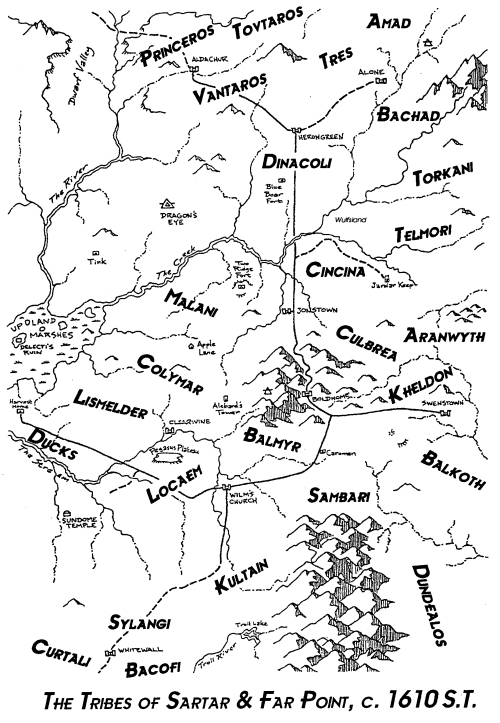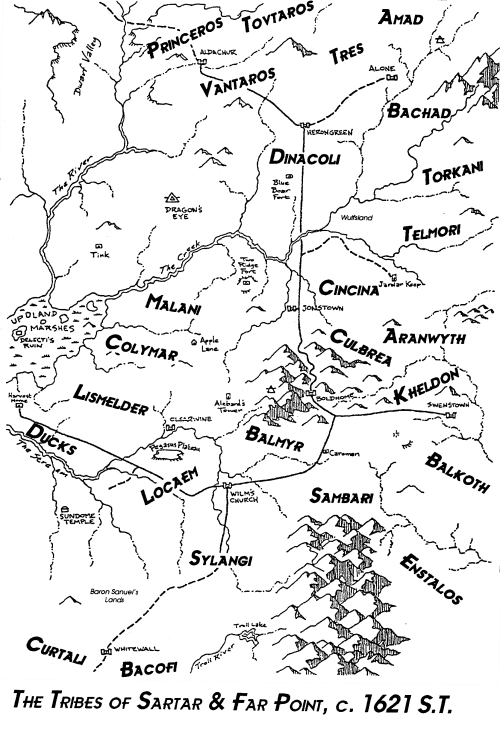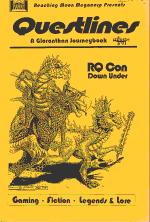
The Tribes and Population of
SARTAR

by David Hall, based on
original figures by Greg Stafford

Tribes of Sartar and the Far Place |
||
|
c.1610
|
c.1621
|
|
The Far Point Tribes (2) |
||
| Princeros |
9,500
|
10,000
|
| Vantaros |
8,500
|
9,500
|
| Tovtaros |
3,500
|
4,000
|
| Tres |
4,000
|
3,000
|
| Amad |
2,500
|
2,000
|
| Bachad |
6,000
|
4,500
|
| Dinacoli (3) |
9,000
|
9,000
|
The Jonstown Confederation |
||
| Cinsina |
5,000
|
7,500
|
| Culbrea (4) |
11,000
|
6,000
|
| Malani |
10,000
|
11,000
|
| Torkani (5) |
9,500
|
8,000
|
The Swenstown Confederation |
||
| Aranwyth |
6,000
|
7,500
|
| Balkoth |
5,000
|
5,500
|
| Dundealos (6) |
10,000
|
---
|
| Enstalos |
---
|
3,000
|
| Kheldon |
6,000
|
4,000
|
The Wilmskirk Confederation |
||
| Balmyr |
7,000
|
9,500
|
| Kultain (7) |
9,500
|
---
|
| Locaem |
7,000
|
8,500
|
| Sambari (8) |
8,500
|
8,000
|
Other Tribes and Groups |
||
| Colymar (9) |
18,000
|
15,500
|
| Lismelder |
5,000
|
5,000
|
| Ducks (10) |
8,500
|
7,000
|
| Telmori |
10,000
|
8,500
|
| Sylangi |
---
|
6,000
|
| Wulfsland (11) |
500
|
3,000
|
| Sun County |
11,000
|
12,000
|
Major Cities |
||
| Alda-chur |
3,000
|
3,500
|
| Alone |
1,000
|
500
|
| Jonstown |
1,500
|
2,000
|
| Duck Point |
500
|
100
|
| Wilmskirk |
1,000
|
1,500
|
| Swenstown |
1,000
|
1,000
|
| Boldhome |
10,500
|
11,000
|
Total (12) |
209,000 |
197,000 |
Human |
200,000 |
189,000 |
Hail Harshax!
Greetings to my fellow scholars. Recently, various Lunar Survey Department documents have been discovered which shed light on the official Lunar population estimates for Sartar during their brief occupation in the Third Age. These are of great interest since they provide an impartial view of Sartarite population numbers at this time. Previously the only other information extant on this subject were a few Imperial Taxation returns which are generally regarded as suspect.(1)
I have studied these figures in the light of recent historical research on this period and append various footnotes which might help explain the movements in population.
Please note that these figures are estimates only, based on rudimentary surveys of the settlements across Sartar, records of births and deaths, and census information where available. In addition children below the age of five were not usually counted in population censes (on the understanding that many of them would die before adulthood). I therefore estimate the potential variation on these numbers to be plus or minus twenty percent.
Notes
- Typically Imperial tax collectors
under-reported the populations in their tax regions. This allowed them
to pocket the difference between what they actually collected and what
the Empire expected. As long as this practice was not abused (and a
further amount was paid out as hush money) their superiors rarely reported
them to Argrath's provincial governors.
- Prior to the Lunar invasion of Tarsh,
Far Point was considered to be a part of Tarsh. It was only added to
the Sartarite Kingdom during the reign of Terasarin. The population
of the Far Point tribes was greatly affected by the Righteous Wind Insurrection
of 1611. It was at this time that Harvar Ironfist of the Vantaros tribe
seized control of the region in the name of a local sun god. He was
supported by the Princeros tribe and the majority of the Tovtaros. Those
tribes that opposed him suffered greatly, including the Bachad, Tres
and Amad. During Harvar's rule Far Point became a semi-autonomous region
neither ruled by Sartar or Tarsh, but owing allegiance to the Lunar
Empire.
- The Dinacoli only joined the Far
Point tribes after Starbrow's Rebellion in 1613. Previously they had
been part of the Jonstown Confederation of tribes.
- After Starbrow's Rebellion the Culbrea
were forced by the Lunars to give up three clans to the Aranwyth and
Cincina tribes. A further clan was lost to the Cincina after a short
war in 1615.
- The Torkani suffered after 1613
mainly as a result of their worship of Argan Argar. The Sun-worshipping
Far Point tribes raided their lands throughout the period.
- In 1618 the Dundealos tribe rebelled
against Lunar rule when a Lunar Tax collector raped the daughter of
the tribal king. The Lunar Army made an example of the tribe, most of
whom were either killed, enslaved of forced to flee to their kin in
the Poljoni of Prax. Those that remained were forcibly converted to
the Lunar Way and were joined by Lunar settlers from Tarsh and Aggar.
A new tribe was formed called the Enstalos.
- After the successful invasion of
Volsaxiland in 1619 the Lunar command broke up the Kultain tribe and
distributed its clans to the neighbouring Sartarite and Volaxi tribes.
The majority of clans went to the Sylangi tribe of the Volsaxi. I believe
that this move was meant to reduce the tensions and long-standing rivalries
between the Sartarite and Volsaxi tribes.
- The fall in population of the Sambari
may be the result of a bloody rebellion dated to this period involving
the Firebull clan.
- After Starbrow's Rebellion the Lunars
forced the Colymar to relinquish clans to the Malani and Locaem tribes.
- The ducks were made the main scapegoat
of Starbrow's Rebellion and for many years tax exemptions were given
to those who brought in duck heads.
- Wulfsland was the region which was
granted to Duke Jomes Wulf after his great victory against the Telmori
in 1607. The land previously belonged to the Maboder tribe, whose destruction
by the Telmori precipitated Wulf's campaign. It was settled by farmers
from the Lunar Heartlands and veterans of the Lunar army.
- Some scholars suggest that the Poljoni tribe of Prax should be included in the population of Sartar due to their religious and family ties. I regard such views as erroneous. However, for the record, their population has variously been estimated at between 5,000 and 10,000 during this period.

Map of Sartar generously contributed by Walter Moore

This article was first printed in Questlines #1
Glorantha, HeroQuest, Hero Wars, and Issaries are trademarks of Issaries, Inc. The contents of this page are copyright by David Hall and Walter Moore, 2002; any material derived from Greg Stafford's world of Glorantha is also copyright by Greg Stafford. Glorantha is the creation of Greg Stafford, and is used with his permission.
